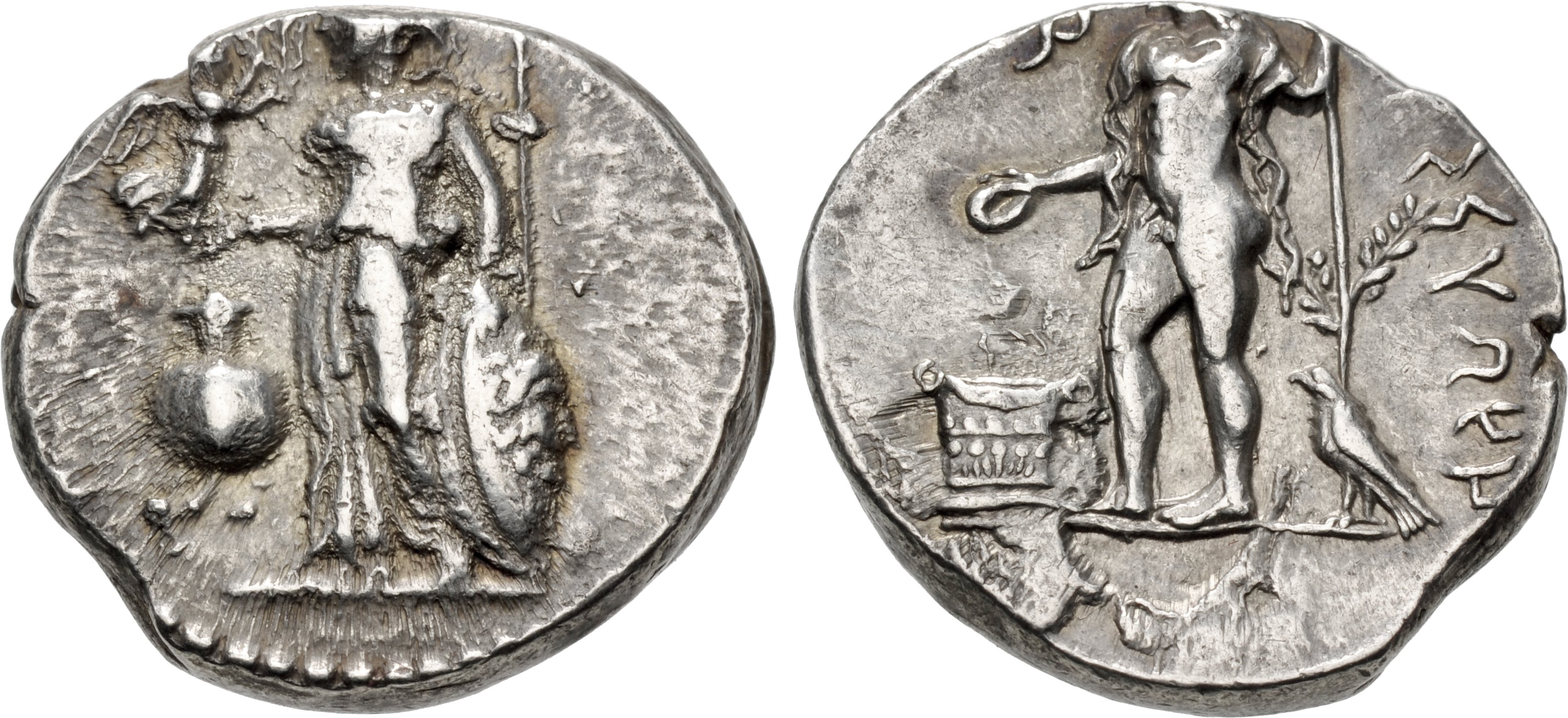Side, silver, double sigloi (Athena/Apollo) (375-333 BCE)
From SILVER
375 BCE - 333 BCE Silver 13,857 kg
Description
| ObverseInscription or printing placed on the obverse.: | Athena left, holding Nike stephanephoros in right hand, left hand resting on shield, in background, behind shield, spear. In left field, pomegrenate. Border of dots. |
| ReverseInscription or printing placed on the reverse.: | (Pamphylian).Apollo standing left, holding long branch, sacrificing out of phiale over altar to left, to lower inner right, bird standing left |
Mint and issuing power
| MintIdentifies the place of manufacture or issue of a numismatic object.: | Side | Ancient regionAncient region.: | Pamphylia | Modern countryModern country: Turkey | AuthorityIdentifies the issuing power. The authority can be "pretended" when the name or the portrait of X is on the coin but he/she was not the issuing power. It can also be "uncertain" when there is no mention of X on the coin but he/she was the issuing power according to the historical sources: | Persian Empire |
Chronology
| FromIdentifies the initial date in a range assigned in a numismatic context. | 375 BCE | toIdentifies the final date in a range assigned in a numismatic context.. | 333 BCE | PeriodTime period of the numismatic object.: Classical 480-323 BC |
Physical description
| MetalThe physical material (usually metal) from which an object is made.: | Silver |
Median weightMedian of the weights of numismatic objects (in grams). in grams | 10.70 | DenominationTerm indicating the value of a numismatic object. Examples: tetradrachm, chalkous, denarius.: | double siglos |
StandardStandard.: | Persian |
Image

AC270 Side Athena Apollo.jpg [1]
References
| Die study referencePublication of the study: | Atlan 19671Atlan 1967, n° 70-9, 85-100, 107-123, Arslan - Lightfoot 19992Arslan - Lightfoot 1999, pl. 10-12 | ||
| Coin series referenceReference to coin series study: | Sear II3Sear II, n° 5428 and 5430, RQEMAC4RQEMAC, n° 270 | ||
| Coin series web referenceCoin series web references: | |||
Obverse dies distribution
| FrequencyFrequency of specimen in distribution. ᵖ | Number of obversesNumber of obverse dies. ᵖ (o) | % (o) | Number of coinsNumber of coins. (n) | % (n) | Die nameName(s) of the die(s). |
| 1 | 28 | 65.12 | 28 | 29.47 | 70, 71, 72, 73, 74, 75, 76, 77, 78, 79, 87, 88, 89, 90, 92, 94, 96, 97, 107, 108, 109, 110, 112, 114, 115, 116, 117, 120 |
| 2 | 7 | 16.28 | 14 | 14.74 | 91, 93, 98, 99, 111, 119, 122 |
| 3 | 3 | 6.98 | 9 | 9.47 | 86, 95, 100 |
| 4 | 1 | 2.33 | 4 | 4.21 | 85 |
| 6 | 1 | 2.33 | 6 | 6.32 | 118 |
| 9 | 1 | 2.33 | 9 | 9.47 | |
| 12 | 1 | 2.33 | 12 | 12.63 | 113 |
| 13 | 1 | 2.33 | 13 | 13.68 | 121 |
| Total | 43 of 43 | 100.03 | 95 of 95 | 99.99 |
Reverse dies distribution
no distribution is available
Quantification
| Number of obversesNumber of obverse dies. ᵖ (o) | 43 | Number of singletons (o1)The number of singleton coins. ᵖ | 28 |
| Number of reverse diesNumber of reverse dies. (r) | 64 | Number of coinsNumber of coins. (n) | 95 |
| Coins per obverse dieNumber of coins per obverse die. (n/o) | 2.21 | Coins per reverse dieNumber of coins per reverse die. (n/r) | 1.48 |
| Reverse per obverse ratioRatio of obverse dies divided by reverse dies. (r/o) | 1.49 | Percentage of singletons (o1)number of coins (n) divided by the number of singletons (o1) ᵖ | 65.12 % |
| Original number of dies (O) (Carter 1983 formula)The estimation of the number of coins according to Carter 1983 ᵖ | 64.75 | Coins struck if 20,000 as average productivity per dieCoins made if the average productivity for obverses (according to Carter) is 20,000. ᵖ | 1,295,000 |
| Original number of dies (O) (Esty 2011 formula)The estimation of the number of coins according to the singleton formula in Esty 2011 ᵖ (O) | 78.56 | Survival rate if 20,000 as average productivity per dieSurvival rate if average productivity is 20,000. ᵖ | 0.00007 |
| Coverage (o = % of O) (Esty 1984 formula)Esty 1984 - coverage (% of O) ᵖ (o = % of O) | 70.53% | Die productivity if survival rate 1/2,000Average productivity if survival rate is 1/2,000. ᵖ | 2,934.36 |
| Weight of silver (in kg) if 20,000 coins per die (O = Carter formula)Carter 1983 * Median weight * 20000 (*10 if gold or electrum) ᵖ | 13,857 kg <br /> 13,857 kg | Die productivity if survival rate 1/5,000Average productivity if survival rate is 1/5,000. ᵖ | 7,335.91 |
Remarks
Most likely one single workstation Arslan - Lightfoot 1999, pl. 10-12: die study of the coins in the Gazipasa Hoard: 38 coins, 18 obv., 28 rev.